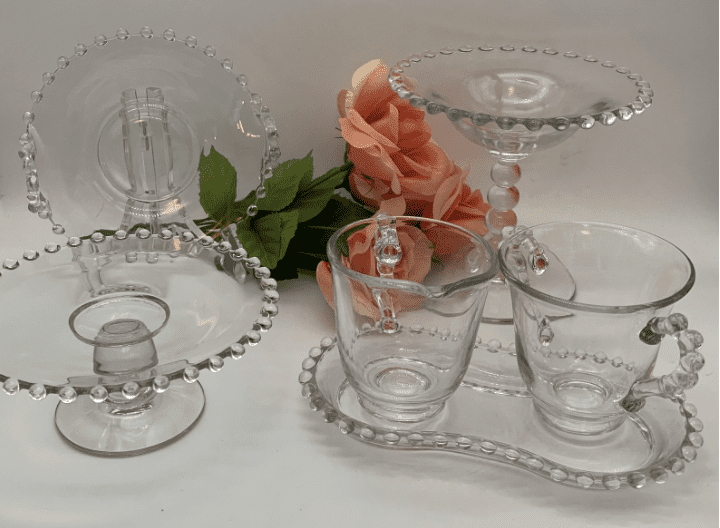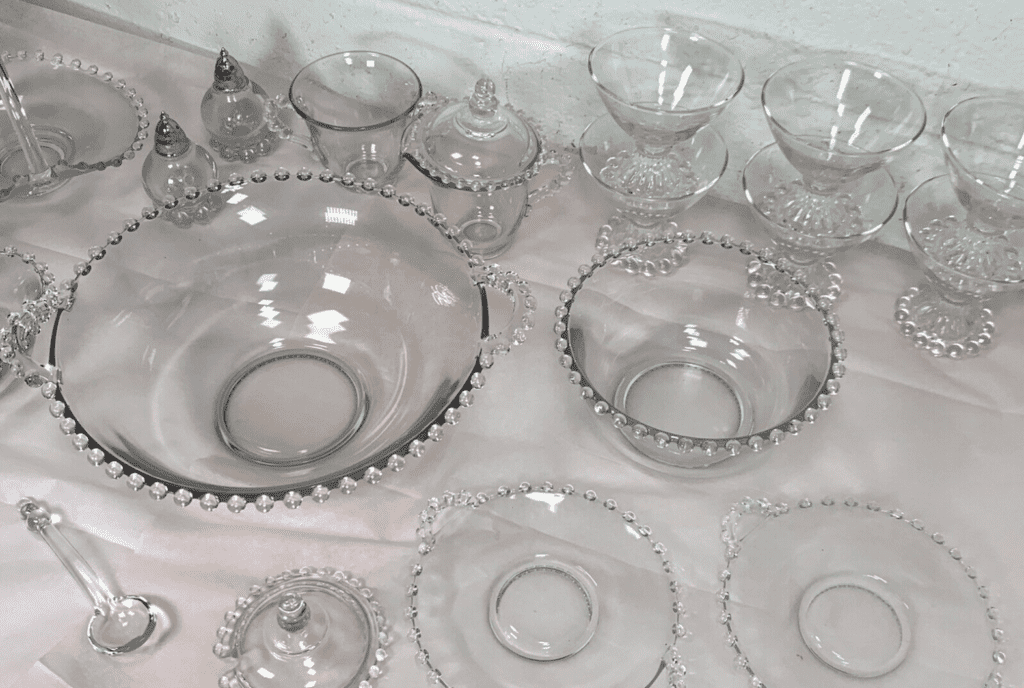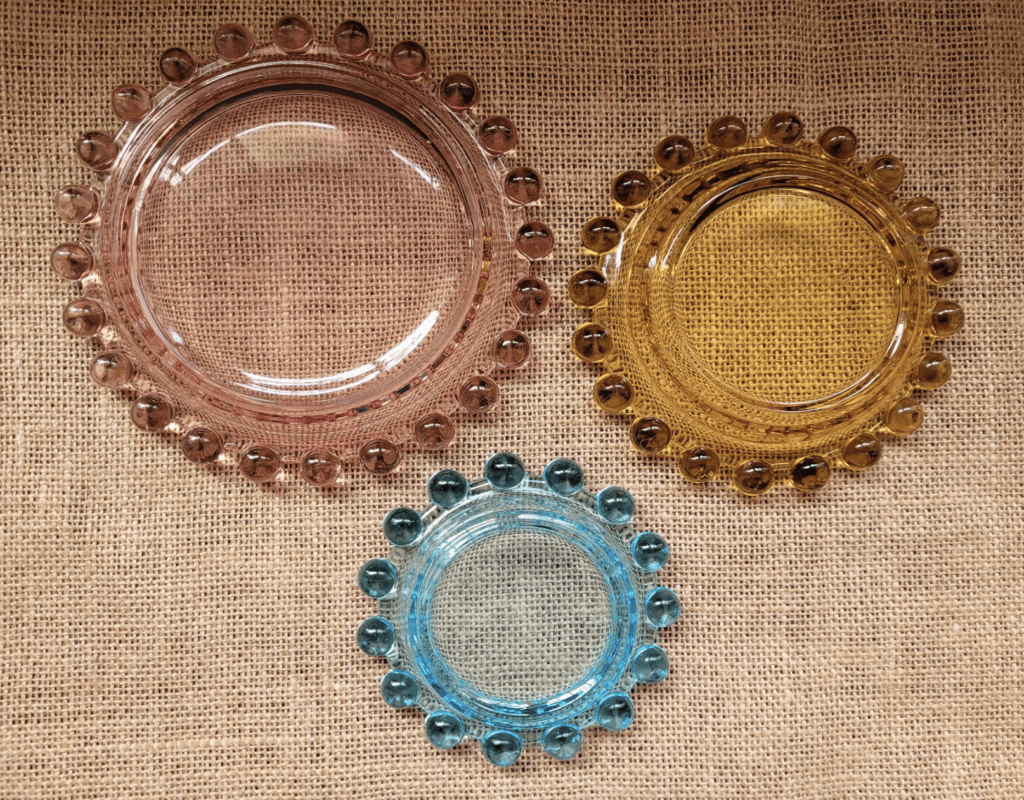Candlewick glassware pieces are antiques that are a reminder of the past. Today, they hold a lot of value with collectors and are recognizable by their unique design.
Candlewick glass is glass that was manufactured by the Imperial Glass Company from 1936 to 1984. These antique glass pieces are characterized by the tiny glass beads that are interwoven into a variety of beautiful patterns on the surface of the glass.
This article discusses the characteristics and the history of Candlewick glass, as well the ways you can identify and value different pieces, so keep reading to learn more!

Characteristics of Candlewick Glassware
There are so many different shapes and designs of Candlewick glass. Teacups, dinner plates, and wine glasses are some of the most common Candlewick designs. There are also more unique pieces that have been made out of Candlewick glass, such as punch bowls, cigarette boxes, nut dishes, ashtrays, and banana bowls.

All Candlewick pieces are recognizable by the embroidery-like pattern that is etched across the glass. This pattern is known as “candlewicking.” Candlewicking is the rows of tiny glass beading that lines the rims and handles of Candlewick glassware. This pattern is unique to Candlewick glassware and is the easiest way to identify authentic pieces.
Candlewick glassware is fine quality crystal. These pieces are made of smooth glass that has excellent clarity. The quality of Candlewick glassware is usually better than that of traditional depression glass. Most Candlewick pieces are colorless or have a blueish tint. However, there are a few pieces that have been made with beautiful colors. These pieces are typically more valuable. Dusty blue, smoky brown, and pale green are some common colors that were produced in the 1970s.

History of Candlewick Glassware
The Imperial Glass Company produced all Candlewick Glass. When this company shut down, so did the production of Candlewick pieces. The Imperial Glass Company was located in Bellaire, Ohio and began manufacturing in 1936. The company’s president and founder was named Edward Muhleman. Muhleman drew inspiration from French glassware designs and incorporated them into his American company.
Within six months of its creation, the Imperial Glass Company became a major player in the handmade glass industry. It employed hundreds of skilled workers. Imperial continued to release new lines of glassware that were all very popular. This company was known for its clear glass and great quality products.

Later on, Edward Newton became the president of the company. Newton helped expand the company greatly. He was an ambitious man who had creative ideas about new and unique glassware lines. He valued good quality production and strove for an elegant look in all of the glassware that the Imperial Glass Company produced.
Unfortunately, the company’s success came to an end. Near the end of its life, foreign competition and a deteriorating economy hurt the Imperial Glass Company significantly. With each year, their workforce dwindled and they began to lose money. In 1984, the company filed for bankruptcy. The production of Candlewick glassware stopped and the glassware became antique pieces that are a reminder of the past. (Source)
How to Tell if Your Candlewick Is Real
Authentic Candlewick glassware is determined by its glass beads. On flat glassware such as plates, ashtrays, and candy dishes, the glass beads should never touch on the horizontal plane. The beads on the stems of Candlewick glassware have more variety. Beads on the stems vary in size and may touch each other on the vertical plane.
There are no safe edges on authentic Candlewick glassware. A safe edge is known as a bump on the interior edge of the rim of the glass. Candlewick glass is known for its smooth surfaces. Real candlewick pieces will not have any bumps or irregularities on the surface of the glass. (Source)
Value of Candlewick Glassware
Different Candlewick pieces will have different values. Candlewick glassware has become a valuable collectible item. It is so sought after because of its beautiful and elegant designs. Candlewick is also valuable because of its interesting past. This glass is a reminder of the Great Depression and the beauty that was still found in those difficult times.
Factors such as age, item type, size, color, and condition all affect the value of these glass pieces. Pieces dating before 1940 are more valuable because they are very rare. Colors also affect the value of certain pieces. Colors like ice green and marigold a rare and highly prized. Ice green pieces have sold for over $16,000.
The item type can also affect the value of the piece. Commonplace items (including things such as plates and glasses) hold the least value. These items typically are worth $10-$15 dollars per piece. The more unique items, the more valuable they are. Some examples of rare items include banana boats and punch bowls. A 15-piece gold punch set is worth around $3,750. These rare pieces are highly sought after.
Is Candlewick Considered Depression Glass?
Depression glass is glassware that was produced from 1929 through 1939. This glass was machine-made and was often clear or colored translucent. It was distributed at a very low cost across the United States and Canada during the Great Depression. There is some confusion on whether Candlewick can be considered Depression Glass.
For most collectors, Candlewick is not considered Depression glass. Candlewick glassware emerged slightly after the Great Depression. Candlewick glassware represents an attempt at returning to elegance after years of facing poverty due to the Great Depression. Candlewick is more elegant and made with higher quality than depression glassware. The fancy serving pieces that were made with Candlewick glassware show Americans’ growing interest in entertaining as households emerged from rough financial times.
Candlewick glassware is made with care and attention to detail. The fancy pieces create an elegant look in the home they are placed in. Depression glass is more plain and practical. Depression glass was produced in great numbers as an attempt to provide struggling families with some sort of utensils. Although the timeline of Candlewick production and Depression glass production overlap slightly, the majority of Candlewick glassware was produced after the Depression-era.

